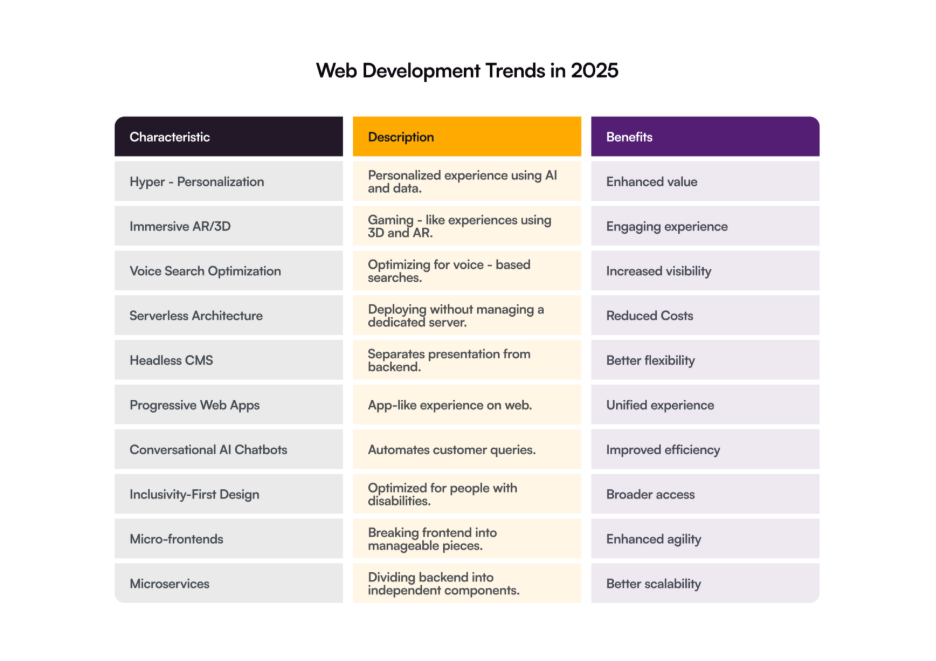Web development is a constantly evolving field, and changing user behavior is the driving force behind it. How users interact with websites and web applications today differs from how they used to interact a few years ago.
Indeed, there was a time when websites looked like a directory of information with little or no user interactions, and today’s websites are more dynamic, interactive, and feel much like a desktop or mobile application.
Thanks to different web development trends, over the years, user experience has significantly improved. As every year there are changes in user behavior, new trends in web development emerge – AI chatbots and voice search for example.
If you are considering developing a website or web application, understanding the latest web development trends in 2025 is essential to develop a state-of-the-art solution to stay competitive. By implementing the latest trends in web development, you can create the best user experience.

Hyper-Personalization
A major shift in user behavior today is their expectation for a personalized experience. Imagine when a user logs in to your website, they find recommendations for products, articles, news content, or anything else that it has to offer. This is the practical use of hyper-personalization.
Such functionality improves user experience and reduces user churn by offering enhanced value. Hyper-personalization uses AI and data to offer personalized services and product recommendations by analyzing users’ search/purchase history, physical location, and other factors.
Today’s customers expect brands to know them and understand what they need. Brands that value personalization are 71% more likely to earn loyal customers compared to only 48% of the possibility for brands that don’t offer personalization, as per Deloitte research.
Businesses are widely using the hyper-personalization web development trend, and you can also use it with the following features.
- AI-driven dynamic content delivery is a data-driven content delivery strategy for websites and web apps to offer personalized experience.
- Personalization offers content that resonates with users, making them more likely to engage with content.
- Your business can gather data from CRMs, websites, feedback, and other sources to offer personalization.
Immersive AR and 3D Experiences
Gaming-like experiences are quite popular among younger generations. Many businesses have recognized it and adapted UIs for their websites and web apps to attract such users. Therefore, websites and web apps with rich 3D and AR experiences have emerged among the top web development trends in 2025.
The use of APIs like WebGPU enables web developers to create immersive web experiences with 3D worlds, parallel computing, high-performance graphics, and advanced features. You can develop more interactive and realistic web experiences by leveraging AR/VR technologies.
Apart from creating gaming-like experiences, AR/VR has many other excellent uses for websites and web apps. For example, IKEA Place is a good example of how VR works in which customers use their smartphones to visualize virtual furniture and place them in different places in their house to see where it fits the best.
Similarly, virtual try-ons help customers virtually try clothes to see how they fit and look. These features on websites and web apps help users make decisions. 3D elements and graphics in UIs create an engaging experience that not only attracts users but also encourages them to take specific actions.
Voice Search Optimization
Although it’s not a new trend, voice search optimization remains one of the top trends in web development in 2025. The increasing popularity of virtual assistants like Google Assistant, Siri, and Alexa have accelerated this trend. Users are leveraging voice assistants and smart speakers not only for listening to music and searching for information; they also leverage them for shopping.
With voice-based commands, virtual assistants can help users conveniently search for information and order food, book movie tickets, or purchase a product. So, optimizing voice search has become crucial to ensure that your website is visible in these searches. Voice recognition and artificial intelligence are the key technologies behind voice search functionality.
Serverless Architecture
Serverless architecture is one of the top web development trends becoming popular to build efficient and high-performance web solutions. It is a revolutionary technology in web development that enables you to deploy your website or web application and its functions without managing a dedicated server. You can use the cloud to deploy, manage, and scale your website or web app.
There are many advantages to using this model like faster time-to-market, reduced operational costs, and automatic scaling because resources are dynamically allocated. The cloud resources can be scaled up easily on demand to handle increased traffic for your website and web app.
With serverless architecture, you can focus on developing a robust website or web app without being concerned about the deployment environment. This allows you to create a customizable frontend of your website or web app while using a plug-and-play backend.
Headless CMS
Managing content on your website or web app can be challenging without a CMS (Content Management System) that provides a single interface for managing all content. There are many top CMS platforms like WordPress, Drupal, Joomla, etc.
Moreover, the use of headless CMS is one of the key trends in web development today that offers a more flexible way to manage content. A headless CMS separates the presentation layer from the backend layer. APIs play a vital role in connecting the backend to the frontend. So, the data is managed via APIs by fetching data from backend to presenting it on the frontend.
There are several headless CMS like Strapi, Contentful, and Umbraco that separates the content repository from the presentation layer and allows managing content through APIs. Headless CMSs offer better flexibility and customization in presentations over traditional CMS. Besides, you can freely decide which framework or technology to choose for frontend.
Progressive Web Apps
Among the different web development trends is PWA that has taken web experience to a whole new level. A progressive web app (PWA) is downloadable and can be installed on a mobile or desktop. It offers an app-like experience with offline functionality. Companies like Pinterest, Instagram, Starbucks, and Uber have already launched their PWAs.
The use of PWAs is a popular web development trend that will continue in 2025 and beyond. You can increase user engagement, attract more audiences, and increase revenue by investing in PWA development.
Progressive web apps offer many app-like features like push notifications, installation, and offline accessibility. These applications ensure a unified experience across different platforms like desktops and mobile devices.
Conversation AI Chatbots
Customer support is often hectic, time consuming, and slow. The introduction of conversational AI bots has revolutionized this field. Conversational AI bots transform overall customer experience by improving operational efficiency, enhancing user engagement, and offering personalized experience.
With the advancements in natural language processing and machine learning, AI bots are now widespread, and companies use them to streamline their customer support services. With the use of these bots, your business can automate customer queries and minimize time while improving overall user experience.
These bots offer many advantages for your business, from interactively handling customer queries to providing help to fix their issues instantly. Conversational AI bots transform the way users interact and fix their issues.
Inclusivity-first Design
Inclusivity-first design focuses on developing web solutions that are optimized for over 1 billion people living with disabilities worldwide. It focuses on creating an accessibility-first and inclusive web solution that allows a broader spectrum of people to use it without a hitch.
This is a vital web development trend and requires you to build solutions that comply with WCAG (Web Content Accessibility Guidelines). These guidelines provide necessary recommendations for creating interactive and inclusive web solutions.
Micro-frontends
Micro-frontend is another popular web development trend today that helps create flexible and scalable architectures for web apps and websites. It involves breaking a monolithic frontend application into manageable pieces. Each piece in such a front-end application is an independent and self-contained module.
Each of these micro-frontends are created, tested, and deployed independently that enhances agility, scalability, and maintainability. These modules create a cohesive and unified interface providing a smooth user experience.
Each of the modules in micro-frontends can be managed by separate teams that reduce complexity. It is a suitable architecture for larger applications that require multiple teams to manage it. Netflix is an ideal example of such applications that leverage micro-frontends.
Microservices
Microservices are akin to micro-frontends but define the architecture for the backend of an application. In this case, an application is divided into smaller components called microservices that are independent from each other and can be developed, tested, and deployed individually.
Microservices have emerged as a prominent web development trend in 2025 and have been adopted by many companies like Amazon, Spotify, Netflix, and PayPal. The key advantages of microservices include flexibility, scalability, security, and easy maintenance.
Just like micro-frontends, microservices can be managed by different teams, and they are self-contained deployed or managed without affecting other microservices. These microservices work cohesively to make a web application functional.
To Wrap Up
Web development has been evolving rapidly over the years, and there are many new innovations that are shaping the future of this domain. If you want to develop a website or web application, knowing and implementing these trends is crucial to developing a top-notch solution.
As 2025 unfolds, trends like AI-driven personalization, progressive web apps, voice search optimization, and headless development are setting new benchmarks for user experience and performance. Staying ahead means more than just keeping up — it’s about embracing change with a future-focused mindset.
Whether you’re starting fresh or upgrading an existing platform, adopting these cutting-edge web development trends will help your business stay relevant, competitive, and ready for the next digital leap.
At Galaxy Weblinks, we leverage these top trends to help businesses create cutting-edge websites and web applications. We are a well-established web development company with 25+ years of experience in the domain.
Contact us to discuss your project and help you develop a robust website or web application.

